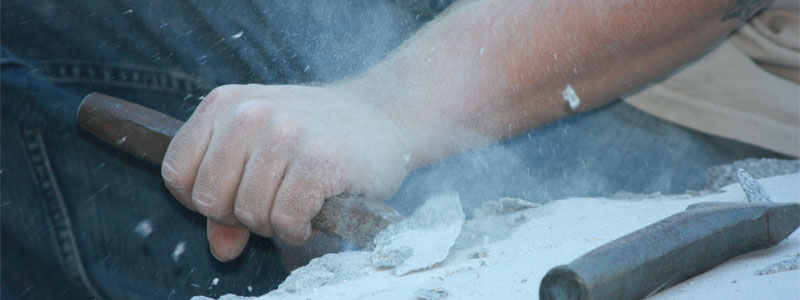
Granite is a natural stone that starts as molten rock. The type of granite is determined by the minerals that were mixed together to create the molten rock and by the rate at which the granite cools and solidifies. If granite cools rapidly, it will be a fine grain stone and if cooled slowly, its grain will be coarser.
To get the granite out of the ground, it is quarried into blocks. This is done with the use of a jet burner. The jet burner is like a small rocket motor burning fuel oil and oxygen. The flame leaves the burner at about five times the speed of sound and at about 3000 degrees Fahrenheit. The burner cuts through the granite forming channels at the ends and back of what will become a block of granite. Holes are then drilled across the bottom to meet the back channel and loaded with black blasting powder. When the explosive detonates, the block is “lifted” or cut free from the surrounding stone. The block, about 4 feet deep, 4 feet high and 8 feet long and weighing as much as 10 tons, is loaded on a truck for the trip to the manufacturing plant.
At the manufacturing plant, the block is cut into slabs from 3 to 12 or more inches thick with diamond rotary saws about 14 feet in diameter. The slabs are then taken to an automatic polishing machine that polishes the slab to a beautiful, almost mirror-like surface. The slab is then run through a guillotine that splits the slab into the required sizes. The rough edges are finished and trimmed by trained craftsmen using traditional hammers and chisels. The monument may now be polished on the edges or left rough depending on what is ordered. The last step here is to package it and ship it off to your local monument builder.
Often your monument builder will have made the design on a computer using a CAD system. This will allow him to cut a rubber stencil by using a special plotter driving a knife. The monument is coated with a glue or “filler” and the stencil is applied to the stone. The areas of the stencil to be sandblasted are removed and the stone is then rolled into a blasting room or cabinet and blasted. The art of sandblasting compliments the artistry of the designer to get the monument to look just right. Here also is where many different textures or finishes can be applied for a more unique appearance. The stencil is then removed, the monument is cleaned and it is ready to be set in the cemetery.
View our full library of MBFilms to learn more about the art, craft, and value of memorialization.
It's difficult to imagine the incredible amount of work that goes into creating a memorial. This video shows brief scenes from several steps of the process.